Fast and Accurate Motion Estimation using Orientation Tensors and ...
Fast and Accurate Motion Estimation using Orientation Tensors and ...
Fast and Accurate Motion Estimation using Orientation Tensors and ...
You also want an ePaper? Increase the reach of your titles
YUMPU automatically turns print PDFs into web optimized ePapers that Google loves.
<strong>Fast</strong> <strong>and</strong> <strong>Accurate</strong> <strong>Motion</strong> <strong>Estimation</strong> <strong>using</strong> <strong>Orientation</strong><br />
<strong>Tensors</strong> <strong>and</strong> Parametric <strong>Motion</strong> Models<br />
Abstract<br />
<strong>Motion</strong> estimation in image sequences is an important<br />
step in many computer vision <strong>and</strong> image processing applications.<br />
Several methods for solving this problem have been<br />
proposed, but very few manage to achieve a high level of accuracy<br />
without sacrificing processing speed.<br />
This paper presents a novel motion estimation algorithm,<br />
which gives excellent results on both counts. The algorithm<br />
starts by computing 3D orientation tensors from the image<br />
sequence. These are combined under the constraints of<br />
a parametric motion model to produce velocity estimates.<br />
Evaluated on the well-known Yosemite sequence, the algorithm<br />
shows an accuracy which is substantially better than<br />
for previously published methods. Computationally the algorithm<br />
is simple <strong>and</strong> can be implemented by means of separable<br />
convolutions, which also makes it fast.<br />
1 Introduction<br />
<strong>Motion</strong> estimation algorithms always involve a trade-off<br />
between speed <strong>and</strong> accuracy. The method presented here<br />
is primarily intended to be accurate but some compromises<br />
have been made in order to keep it fast as well.<br />
The primary measurements on the image sequence are<br />
made by spatiotemporal filtering, in the form of estimation<br />
of 3D orientation tensors. This gives a powerful representation<br />
of the local constraints on the motion that can<br />
be inferred from the intensity variations. In neighborhoods<br />
where the aperture problem only allows direct detection of<br />
the normal velocity component, this fact is accurately reflected<br />
in the tensor. The tensor field is also well suited for<br />
estimation of parametric motion models over larger regions.<br />
The algorithm uses this technique to improve the accuracy;<br />
for each point the velocity is computed under the constraint<br />
Gunnar Farnebäck<br />
Computer Vision Laboratory<br />
Department of Electrical Engineering<br />
Linköping University<br />
SE-581 83 Linköping, Sweden<br />
gf@isy.liu.se<br />
of affine motion in a neighborhood. Other parametric motion<br />
models than the affine can be used as well. The constant<br />
motion model (pure translation) in particular gives less<br />
accuracy but higher speed.<br />
Spatiotemporal filtering <strong>and</strong> parametric motion models,<br />
in particular affine motion, are today st<strong>and</strong>ard components<br />
of motion estimation algorithms. The use of orientation tensors<br />
is, however, less common. The basic relations between<br />
3D orientation tensors <strong>and</strong> motion have been explored in<br />
e.g. [3, 10, 9, 20, 8]. A more sophisticated tensor based<br />
algorithm has been presented by Karlholm [14]. His algorithm<br />
has some elements in common with the one presented<br />
here, but differs in the method for estimation of tensors <strong>and</strong><br />
in that it uses a maximum likelihood approach to estimate<br />
motion model parameters. A survey of some other tensor<br />
based approaches can be found in [12].<br />
2 <strong>Orientation</strong> tensors<br />
By stacking the frames of an image sequence onto each<br />
other we obtain a spatiotemporal image volume with two<br />
spatial dimensions <strong>and</strong> a third temporal dimension. It is<br />
easy to see that movement in the image sequence induces<br />
structures with certain orientations in the volume. A translating<br />
point, e.g., is transformed into a line whose direction<br />
in the volume directly corresponds to its velocity.<br />
A powerful representation of local orientation is the orientation<br />
tensor [8, 15]. In 3D this tensor takes the form of<br />
a 3 × 3 symmetric positive semidefinite matrix T <strong>and</strong> the<br />
quadratic form û T Tû can be interpreted as a measure of<br />
how much the signal locally varies in the direction given by<br />
û.<br />
To estimate 3D orientation tensors we use a new method<br />
by Farnebäck, described in [6]. The basis for this method is<br />
to locally, for each neighborhood, project the signal onto a
second degree polynomial, according to the signal model<br />
f(x) ∼ x T Ax + b T x + c. (1)<br />
The parameters A, b, <strong>and</strong> c are computed by a weighted<br />
least squares approximation of the signal, where the weighting<br />
function normally is a Gaussian. (As is shown in [6], the<br />
weighting function must be chosen with care. Unweighted<br />
projection is not to be recommended.) It turns out that this<br />
in practice can be implemented very efficiently by a hierarchical<br />
scheme of separable convolutions. From the model<br />
parameters, the orientation tensor is constructed by<br />
T = AA T + γbb T , (2)<br />
where γ is a non-negative weight factor between the even<br />
<strong>and</strong> the odd parts of the signal. The value of γ, as well as the<br />
st<strong>and</strong>ard deviation σ of the Gaussian weighting function,<br />
depend on the scale of the structures for which we wish to<br />
estimate orientation <strong>and</strong> are available as design parameters.<br />
A 2D velocity vector (vx vy) T , measured in pixels per<br />
frame, can be extended to a 3D spatiotemporal directional<br />
vector v <strong>and</strong> a unit directional vector ˆv by<br />
⎛ ⎞<br />
vx<br />
v = ⎝vy⎠<br />
, ˆv =<br />
1<br />
v<br />
. (3)<br />
�v�<br />
Ideally, if we have exact translation <strong>and</strong> no noise, there<br />
would locally be no variation in the volume along the direction<br />
of ˆv. Thus we would have ˆv T Tˆv = 0 <strong>and</strong> the velocity<br />
could be recovered from the eigenvector of T with eigenvalue<br />
zero. In the case of a moving line we have the aperture<br />
problem, i.e. only the normal velocity component can<br />
be detected, which causes T to have a double eigenvalue<br />
zero. Then all velocities with the correct normal velocity<br />
satisfy ˆv T Tˆv = 0. Further details on how to compute point<br />
velocity <strong>and</strong> normal velocity from tensors can be found in<br />
[8].<br />
In practice we cannot require ˆv T Tˆv to be zero, but it<br />
suffices to minimize the expression. The minimum value<br />
is given by the smallest eigenvalue λ3 <strong>and</strong> by writing T =<br />
˜T + λ3I we can see that ˆv T Tˆv = ˆv T ˜Tˆv + λ3ˆv T Iˆv =<br />
ˆv T ˜Tˆv + λ3. The conclusion is that we can remove λ3I, the<br />
isotropic part, from the tensor without changing the solution<br />
to the minimization problem. For computational reasons we<br />
will later prefer to minimize v T Tv rather than ˆv T Tˆv but<br />
then we have v T Tv = v T ˜Tv + λ3v T v, which would be<br />
clearly biased against large velocities. Therefore we replace<br />
the original tensor T by the isotropy compensated tensor ˜T.<br />
To simplify the notation we drop the tilde in the rest of the<br />
presentation.<br />
3 Estimating a parameterized velocity field<br />
Rather than estimating the velocity from the tensors<br />
point for point we assume that the velocity field over a re-<br />
gion can be parameterized according to some motion model<br />
<strong>and</strong> use all the tensors in the region to compute the parameters.<br />
To present the method we use the affine motion model<br />
vx(x, y) = ax + by + c,<br />
vy(x, y) = dx + ey + f,<br />
where x <strong>and</strong> y are image coordinates. This can be rewritten<br />
in terms of the spatiotemporal vector (3) as<br />
(4)<br />
v = Sp,<br />
⎛<br />
x<br />
where<br />
y 1 0 0 0<br />
⎞<br />
0<br />
(5)<br />
S = ⎝0<br />
0 0 x y 1 0⎠<br />
<strong>and</strong> (6)<br />
0 0 0 0 0 0 1<br />
p = � a b c d e f 1 � T . (7)<br />
In order to estimate the parameters p of the motion<br />
model we introduce the cost functions<br />
d(v, T) = v T Tv, <strong>and</strong> (8)<br />
dtot = �<br />
d(vi, Ti), (9)<br />
where the summation is over all points of the region. Applying<br />
the affine motion model we obtain from (5) <strong>and</strong> (8)<br />
i<br />
d(v, T) = v T Tv = p T S T TSp = p T Qp, (10)<br />
where Q = ST TS is a positive semidefinite quadratic<br />
form. Summing these over the region transforms (9) into<br />
dtot(p) = �<br />
d(vi, Ti) = �<br />
p T S T i TiSip<br />
i<br />
= p T<br />
� �<br />
i<br />
Qi<br />
�<br />
i<br />
p = p T Qtotp,<br />
(11)<br />
which should be minimized under the constraint that the last<br />
element of p be 1. In order to do this we partition p <strong>and</strong> Qtot<br />
as<br />
p =<br />
turning (11) into<br />
� �<br />
¯p<br />
, Qtot =<br />
1<br />
�<br />
¯Q q<br />
qT �<br />
, (12)<br />
α<br />
dtot(p) = ¯p T ¯Q¯p + ¯p T q + q T ¯p + α, (13)<br />
which is minimized by<br />
giving the minimum value<br />
¯p = − ¯Q −1 q (14)<br />
α − q T ¯Q −1 q. (15)
Figure 1. One frame of the Yosemite sequence.<br />
In order to use this method of parameter estimation, the<br />
necessary <strong>and</strong> sufficient property of the motion model is that<br />
it is linear in its parameters, i.e. that it can be expressed in<br />
the form (5). See [6] for further examples.<br />
There are two important advantages to estimating the velocity<br />
over a whole region rather than point by point. The<br />
first advantage is that the effects of noise <strong>and</strong> inaccuracies in<br />
the tensor estimation are reduced significantly. The second<br />
advantage is that even if the aperture problem is present in<br />
some part of the region, information obtained from other<br />
parts can help to fill in the missing velocity component.<br />
There does remain a possibility that the motion field cannot<br />
be uniquely determined, but that requires the signal structures<br />
over the whole region to be oriented in such a way<br />
that the motion becomes ambiguous; a generalized aperture<br />
problem.<br />
A disadvantage with velocity estimation over a whole region<br />
is that it is assumed that the true velocity field is at least<br />
reasonably consistent with the chosen motion model. Thus<br />
we would like to somehow find such regions. This can be<br />
done, e.g. by simultaneous segmentation <strong>and</strong> velocity estimation<br />
as in [6], but at the cost of performance. Here we<br />
choose to give priority to speed, ignoring this problem.<br />
4 A fast velocity estimation algorithm<br />
Instead of trying to obtain regions with a coherent motion,<br />
we minimize a weighted distance measure for a motion<br />
Figure 2. Corresponding true velocity field<br />
(subsampled).<br />
model around each point, i.e. (11) is replaced by<br />
dtot(p) = �<br />
wid(vi, Ti) = p T<br />
� �<br />
�<br />
p<br />
i<br />
= p T Qtotp,<br />
i<br />
wiQi<br />
(16)<br />
where the sum is taken over a neighborhood of the current<br />
point <strong>and</strong> the weights wi are given by a Gaussian. In effect<br />
this means that we convolve the quadratic forms Qi over the<br />
image with the weight function, <strong>and</strong> this operation can be<br />
efficiently computed by separable convolution. We can also<br />
view this as a weighted averaging of the quadratic forms.<br />
The optimal parameters are computed at each point according<br />
to (14) by solving a linear equation system <strong>and</strong> the<br />
corresponding velocity estimates are computed by (5). It<br />
also turns out that the minimum value (15) can be used as a<br />
confidence measure, with small values indicating high confidence<br />
in the estimated velocity, since it indicates how well<br />
the local neighborhood is consistent with the motion model<br />
in use.<br />
The algorithm has been implemented in Matlab, with<br />
convolution <strong>and</strong> solution of multiple equation systems in<br />
the form of C mex files. In addition to the affine motion<br />
model, the simpler constant motion model (with S = I,<br />
implying Q = T, <strong>and</strong> p = (a b 1) T ) has also been implemented.<br />
Typical running times for the algorithm on a<br />
360 MHz SUN Ultra 60 are given below <strong>and</strong> relate to the<br />
computation of the velocity for one frame of the 252 × 316<br />
Yosemite sequence.<br />
With the affine motion model, tensors computed <strong>using</strong><br />
filters of effective size 11 × 11 × 11, <strong>and</strong> a 41 × 41 averaging<br />
kernel takes about 16 seconds. Of these, 1.8 seconds<br />
are spent on tensor estimation, 0.5 seconds on isotropy
average error, degrees<br />
3<br />
2.5<br />
2<br />
1.5<br />
1<br />
0.5<br />
0<br />
0 20 40 60 80 100<br />
Coverage (%)<br />
Figure 3. Angular errors for different levels of<br />
coverage. Affine motion model.<br />
compensation, 0.3 seconds on computation of the quadratic<br />
forms Qi, 8.6 seconds on averaging these, <strong>and</strong> 4.8 seconds<br />
on solving for the velocity.<br />
With the constant velocity motion model, 9 × 9 × 9 tensors,<br />
<strong>and</strong> 15 × 15 averaging, the running time is about 3.5<br />
seconds, with 1.6 seconds for tensor estimation, 0.5 seconds<br />
for isotropy compensation, 1.2 seconds for averaging, <strong>and</strong><br />
0.2 seconds for solving for the velocity.<br />
Source code for the implementation is available at<br />
http://www.isy.liu.se/ ˜ gf.<br />
5 Evaluation<br />
The velocity estimation algorithm has been evaluated on<br />
a commonly used test sequence with known velocity field,<br />
Lynn Quam’s Yosemite sequence [11], figures 1 <strong>and</strong> 2. This<br />
synthetic sequence is generated with the help of a digital terrain<br />
map <strong>and</strong> therefore has a motion field with depth variation<br />
<strong>and</strong> discontinuities at occlusion boundaries.<br />
The accuracy of the velocity estimates has been measured<br />
<strong>using</strong> the average spatiotemporal angular error,<br />
arccos(ˆv T estˆv true) [2]. The sky region is excluded from the<br />
error analysis because the variations in the cloud textures<br />
induce an image flow that is quite different from the ground<br />
truth values computed solely from the camera motion.<br />
Using the affine motion model, with filter sizes as in the<br />
discussion on running times <strong>and</strong> σ = 1.6, γ = 1 , <strong>and</strong><br />
256<br />
σavg = 6.5, yields an average angular error of 1.40◦ with<br />
st<strong>and</strong>ard deviation 2.57◦ . Using the constant motion model,<br />
σ = 1.4, γ = 1<br />
32 , <strong>and</strong> σavg = 3.5, the angular error increases<br />
to 1.94◦ with st<strong>and</strong>ard deviation 2.31◦ . Figures 3<br />
<strong>and</strong> 4 show the results at different levels of coverage, us-<br />
average error, degrees<br />
3<br />
2.5<br />
2<br />
1.5<br />
1<br />
0.5<br />
0<br />
0 20 40 60 80 100<br />
Coverage (%)<br />
Figure 4. Angular errors for different levels of<br />
coverage. Constant motion model.<br />
affine constant<br />
Average error 1.40 ◦ 1.94 ◦<br />
St<strong>and</strong>ard deviation 2.57 ◦ 2.31 ◦<br />
< 0.5 ◦ 35.8% 14.1%<br />
Proportion < 1 ◦ 65.0% 39.7%<br />
of estimates < 2 ◦ 82.1% 70.5%<br />
with errors < 3 ◦ 89.7% 83.4%<br />
below: < 5 ◦ 95.4% 92.8%<br />
< 10 ◦ 98.8% 98.6%<br />
Table 1. Distribution of errors.<br />
ing the confidence values (15) to choose which points to<br />
include. The dashed lines give the corresponding st<strong>and</strong>ard<br />
deviations.<br />
Statistics on the distribution of errors for the two motion<br />
models are given in table 1. Comparison with previously<br />
published results, table 2, shows that the algorithm<br />
presented here gives excellent accuracy, with the results for<br />
the affine motion model being substantially better than previously<br />
published methods. A more detailed evaluation can<br />
be found in [6].<br />
6 Conclusions<br />
We have presented a novel motion estimation algorithm,<br />
which is more accurate than other methods <strong>and</strong> still fast.<br />
If one is willing to sacrifice some of the speed, the accuracy<br />
can be improved further. Using the same basic ideas,<br />
but replacing (16) by a simultaneous segmentation <strong>and</strong> motion<br />
estimation algorithm, we can achieve an average angular<br />
error on the Yosemite sequence of 1.14 ◦ with a st<strong>and</strong>ard
Technique Average St<strong>and</strong>ard Density<br />
error deviation<br />
Lucas & Kanade [17] 2.80 ◦ 3.82 ◦ 35%<br />
Uras et al. [19] 3.37 ◦ 3.37 ◦ 14.7%<br />
Fleet & Jepson [7] 2.97 ◦ 5.76 ◦ 34.1%<br />
Black & An<strong>and</strong>an [4] 4.46 ◦ 4.21 ◦ 100%<br />
Szeliski & Coughlan [18] 2.45 ◦ 3.05 ◦ 100%<br />
Black & Jepson [5] 2.29 ◦ 2.25 ◦ 100%<br />
Ju et al. [13] 2.16 ◦ 2.0 ◦ 100%<br />
Karlholm [14] 2.06 ◦ 1.72 ◦ 100%<br />
Lai & Vemuri [16] 1.99 ◦ 1.41 ◦ 100%<br />
Bab-Hadiashar & Suter [1] 1.97 ◦ 1.96 ◦ 100%<br />
constant motion 1.94 ◦ 2.31 ◦ 100%<br />
constant motion 1.43 ◦ 1.24 ◦ 70%<br />
affine motion 1.40 ◦ 2.57 ◦ 100%<br />
affine motion 0.75 ◦ 0.73 ◦ 70%<br />
Table 2. Comparison with other methods,<br />
Yosemite sequence. The sky region is excluded<br />
for all results.<br />
deviation of 2.14 ◦ . The details of this algorithm are beyond<br />
the scope of this paper, but can be found in [6].<br />
Acknowledgments<br />
The author wants to acknowledge the financial support of<br />
WITAS: The Wallenberg Laboratory for Information Technology<br />
<strong>and</strong> Autonomous Systems.<br />
References<br />
[1] A. Bab-Hadiashar <strong>and</strong> D. Suter. Robust optic flow computation.<br />
International Journal of Computer Vision, 29(1):59–<br />
77, August 1998.<br />
[2] J. L. Barron, D. J. Fleet, <strong>and</strong> S. S. Beauchemin. Performance<br />
of optical flow techniques. Int. J. of Computer Vision,<br />
12(1):43–77, 1994.<br />
[3] J. Bigün. Local Symmetry Features in Image Processing.<br />
PhD thesis, Linköping University, Sweden, 1988. Dissertation<br />
No 179, ISBN 91-7870-334-4.<br />
[4] M. J. Black <strong>and</strong> P. An<strong>and</strong>an. The robust estimation of multiple<br />
motions: Parametric <strong>and</strong> piecewise-smooth flow fields.<br />
Computer Vision <strong>and</strong> Image Underst<strong>and</strong>ing, 63(1):75–104,<br />
Jan. 1996.<br />
[5] M. J. Black <strong>and</strong> A. Jepson. Estimating optical flow in segmented<br />
images <strong>using</strong> variable-order parametric models with<br />
local deformations. IEEE Transactions on Pattern Analysis<br />
<strong>and</strong> Machine Intelligence, 18(10):972–986, 1996.<br />
[6] G. Farnebäck. Spatial Domain Methods for <strong>Orientation</strong><br />
<strong>and</strong> Velocity <strong>Estimation</strong>. Lic. Thesis LiU-Tek-Lic-1999:13,<br />
Dept. EE, Linköping University, SE-581 83 Linköping,<br />
Sweden, March 1999. Thesis No. 755, ISBN 91-7219-441-<br />
3.<br />
[7] D. J. Fleet <strong>and</strong> A. D. Jepson. Computation of Component<br />
Image Velocity from Local Phase Information. Int. Journal<br />
of Computer Vision, 5(1):77–104, 1990.<br />
[8] G. H. Granlund <strong>and</strong> H. Knutsson. Signal Processing for<br />
Computer Vision. Kluwer Academic Publishers, 1995.<br />
ISBN 0-7923-9530-1.<br />
[9] L. Haglund. Adaptive Multidimensional Filtering. PhD thesis,<br />
Linköping University, Sweden, SE-581 83 Linköping,<br />
Sweden, October 1992. Dissertation No 284, ISBN 91-<br />
7870-988-1.<br />
[10] L. Haglund, H. B˚arman, <strong>and</strong> H. Knutsson. <strong>Estimation</strong> of<br />
velocity <strong>and</strong> acceleration in time sequences. In Proceedings<br />
of the 7th Sc<strong>and</strong>inavian Conference on Image Analysis,<br />
pages 1033–1041, Aalborg, Denmark, August 1991. Pattern<br />
Recognition Society of Denmark.<br />
[11] D. J. Heeger. Model for the extraction of image flow. J. Opt.<br />
Soc. Am. A, 4(8):1455–1471, 1987.<br />
[12] B. Jähne, H. Haussecker, <strong>and</strong> P. Geissler, editors. H<strong>and</strong>book<br />
of Computer Vision <strong>and</strong> Applications. Academic Press,<br />
1999. ISBN 0-12-379770-5.<br />
[13] S. X. Ju, M. J. Black, <strong>and</strong> A. D. Jepson. Skin <strong>and</strong> bones:<br />
Multi-layer, locally affine, optical flow <strong>and</strong> regularization<br />
with transparency. In Proceedings CVPR’96, pages 307–<br />
314. IEEE, 1996.<br />
[14] J. Karlholm. Local Signal Models for Image Sequence Analysis.<br />
PhD thesis, Linköping University, Sweden, SE-581 83<br />
Linköping, Sweden, 1998. Dissertation No 536, ISBN 91-<br />
7219-220-8.<br />
[15] H. Knutsson. Representing local structure <strong>using</strong> tensors. In<br />
The 6th Sc<strong>and</strong>inavian Conference on Image Analysis, pages<br />
244–251, Oulu, Finl<strong>and</strong>, June 1989. Report LiTH–ISY–I–<br />
1019, Computer Vision Laboratory, Linköping University,<br />
Sweden, 1989.<br />
[16] S.-H. Lai <strong>and</strong> B. C. Vemuri. Reliable <strong>and</strong> efficient computation<br />
of optical flow. International Journal of Computer<br />
Vision, 29(2):87–105, August/September 1998.<br />
[17] B. Lucas <strong>and</strong> T. Kanade. An Iterative Image Registration<br />
Technique with Applications to Stereo Vision. In Proc.<br />
Darpa IU Workshop, pages 121–130, 1981.<br />
[18] R. Szeliski <strong>and</strong> J. Coughlan. Hierarchical spline-based image<br />
registration. In Proc. IEEE Conference on Computer<br />
Vision Pattern Recognition, pages 194–201, Seattle, Washington,<br />
1994.<br />
[19] S. Uras, F. Girosi, A. Verri, <strong>and</strong> V. Torre. A computational<br />
approach to motion perception. Biological Cybernetics,<br />
pages 79–97, 1988.<br />
[20] C.-F. Westin. A Tensor Framework for Multidimensional<br />
Signal Processing. PhD thesis, Linköping University, Sweden,<br />
SE-581 83 Linköping, Sweden, 1994. Dissertation No<br />
348, ISBN 91-7871-421-4.


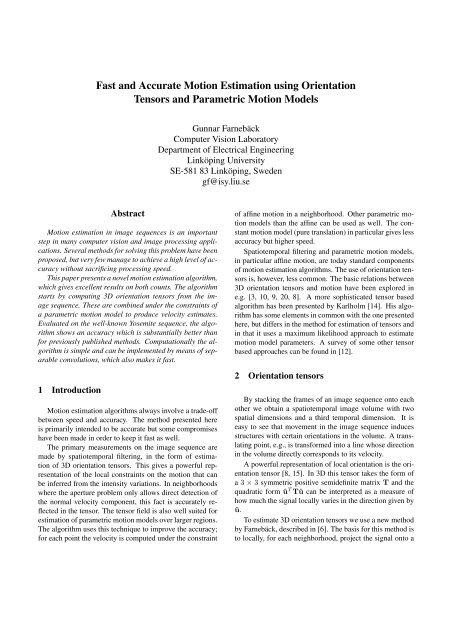
![Download full paper [PDF] - Laboratory of Mathematics in Imaging](https://img.yumpu.com/49647991/1/190x247/download-full-paper-pdf-laboratory-of-mathematics-in-imaging.jpg?quality=85)
![Download full paper [PDF] - Laboratory of Mathematics in Imaging](https://img.yumpu.com/42711677/1/190x253/download-full-paper-pdf-laboratory-of-mathematics-in-imaging.jpg?quality=85)

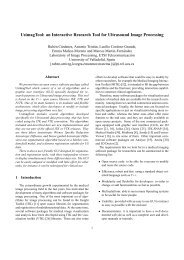
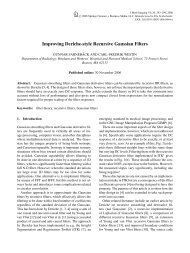

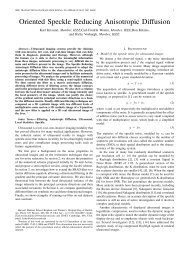
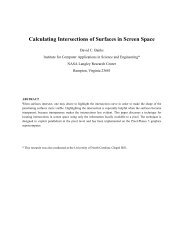
![Download full paper [PDF] - Laboratory of Mathematics in Imaging](https://img.yumpu.com/23088308/1/190x255/download-full-paper-pdf-laboratory-of-mathematics-in-imaging.jpg?quality=85)